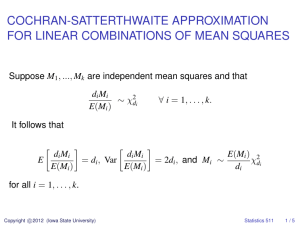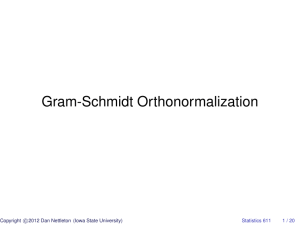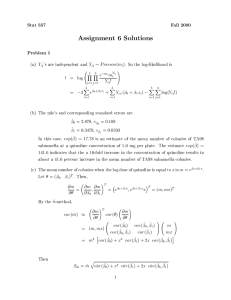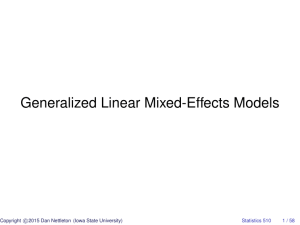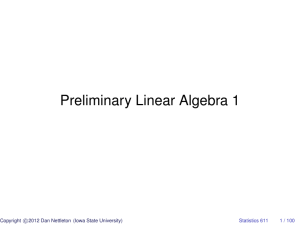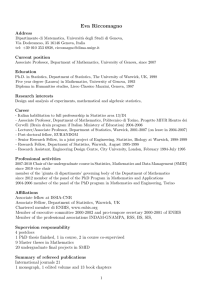Document 10639600
advertisement
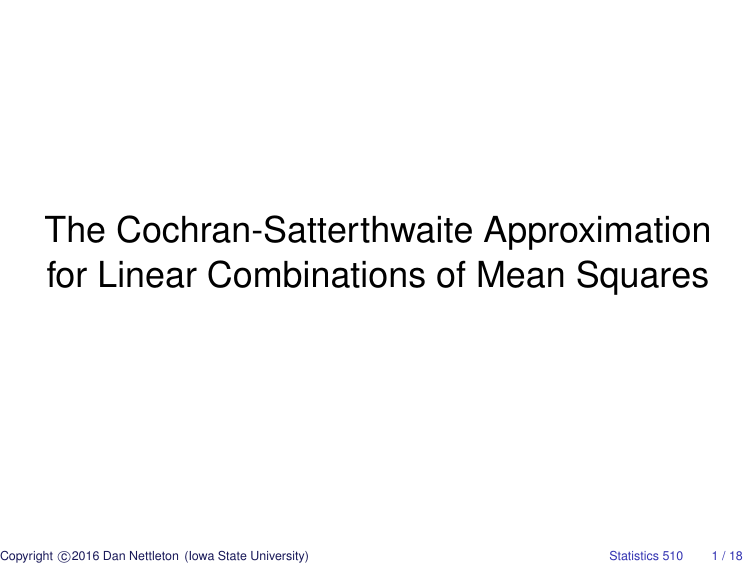
The Cochran-Satterthwaite Approximation for Linear Combinations of Mean Squares c Copyright 2016 Dan Nettleton (Iowa State University) Statistics 510 1 / 18 Suppose M1 , ..., Mk are independent mean squares and that di Mi ∼ χ2di E(Mi ) ∀ i = 1, . . . , k. It follows that di Mi E(Mi ) 2 di Mi = di , Var = 2di , and Mi ∼ χdi E E(Mi ) E(Mi ) di for all i = 1, . . . , k. c Copyright 2016 Dan Nettleton (Iowa State University) Statistics 510 2 / 18 Consider the random variable M = a1 M1 + a2 M2 + · · · + ak Mk , where a1 , a2 , . . . , ak are known constants in R. Note that M is a linear combination of scaled χ2 random variables. The Cochran-Satterthwaite approximation works by assuming that M is approximately distributed as a scaled χ2 , just like each of the variables in the linear combination. dM · 2 · E(M) 2 χd . ∼ χd ⇐⇒ M ∼ E(M) d What choice for d makes the approximation most reasonable? c Copyright 2016 Dan Nettleton (Iowa State University) Statistics 510 3 / 18 If · M∼ E(M) 2 χd , d then E(M) d 2 E(M) d 2 Var(M) ≈ = Var χ2d (2d) 2 [E(M)]2 = d 2 2M ≈ . d c Copyright 2016 Dan Nettleton (Iowa State University) Statistics 510 4 / 18 Now note that Var(M) = a21 Var(M1 ) + · · · + a2k Var(MK ) = a21 h E(M1 ) d1 i2 2d1 + · · · + = 2 Pk a2i [E(Mi )]2 di ≈ 2 Pk a2i Mi2 /di . i=1 i=1 c Copyright 2016 Dan Nettleton (Iowa State University) a2k h E(Mk ) dk i2 2dk Statistics 510 5 / 18 Equating these two variance approximations yields k X 2M 2 =2 a2i Mi2 /di . d i=1 Solving for d yields d = Pk M 2 2 2 i=1 ai Mi /di P = Pk k i=1 ai Mi 2 2 2 i=1 ai Mi /di . This is the Cochran-Satterthwaite formula for the approximate degrees of freedom associated with the linear combination of mean squares defined by M. c Copyright 2016 Dan Nettleton (Iowa State University) Statistics 510 6 / 18 Recall the first example from the last slide set. y111 y121 y= y211 , y212 1 1 X= 0 0 X1 = 1, 0 0 , 1 1 X2 = X, 1 0 Z= 0 0 0 1 0 0 0 0 1 1 X3 = Z y0 (P2 − P1 )y + y0 (P3 − P2 )y + y0 (I − P3 )y = y0 (I − P1 )y c Copyright 2016 Dan Nettleton (Iowa State University) Statistics 510 7 / 18 Expected Mean Squares SOURCE EMS trt 1.5σu2 + σe2 + (τ1 − τ2 )2 xu(trt) σu2 + σe2 ou(xu, trt) σe2 E(1.5MSxu(trt) − 0.5MSou(xu,trt) ) = 1.5(σu2 + σe2 ) − 0.5σe2 c Copyright 2016 Dan Nettleton (Iowa State University) = 1.5σu2 + σe2 Statistics 510 8 / 18 An Approximate F Test The statistic F= MStrt 1.5MSxu(trt) − 0.5MSou(xu,trt) is approximately F distributed with 1 numerator degree of freedom and denominator degrees freedom approximated by the Cochran-Satterthwaite Method: d= (1.5MSxu(trt) − 0.5MSou(xu,trt) )2 2 2 . (1.5)2 MSxu(trt) + (−0.5)2 MSou(xu,trt) c Copyright 2016 Dan Nettleton (Iowa State University) Statistics 510 9 / 18 SAS Code for Example data d; input trt xu y; cards; 1 1 6.4 1 2 4.2 2 1 1.5 2 1 0.9 ; run; c Copyright 2016 Dan Nettleton (Iowa State University) Statistics 510 10 / 18 SAS Code for Example proc mixed method=type1; class trt xu; model y=trt / ddfm=satterthwaite; random xu(trt); run; c Copyright 2016 Dan Nettleton (Iowa State University) Statistics 510 11 / 18 The Mixed Procedure Model Information Data Set Dependent Variable Covariance Structure Estimation Method Residual Variance Method Fixed Effects SE Method Degrees of Freedom Method WORK.D y Variance Components Type 1 Factor Model-Based Satterthwaite Class Level Information Class trt xu Levels 2 2 Values 1 2 1 2 c Copyright 2016 Dan Nettleton (Iowa State University) Statistics 510 12 / 18 Dimensions Covariance Parameters Columns in X Columns in Z Subjects Max Obs Per Subject 2 3 3 1 4 Number of Observations Number of Observations Read Number of Observations Used Number of Observations Not Used c Copyright 2016 Dan Nettleton (Iowa State University) 4 4 0 Statistics 510 13 / 18 Type 1 Analysis of Variance Source trt xu(trt) Residual DF Sum of Squares Mean Square 1 1 1 16.810000 2.420000 0.180000 16.810000 2.420000 0.180000 Source Expected Mean Square Error Term trt Var(Residual)+1.5 Var(xu(trt))+Q(trt) 1.5 MS(xu(trt)) - 0.5 MS(Residual) xu(trt) Var(Residual)+Var(xu(trt)) MS(Residual) Residual Var(Residual) . c Copyright 2016 Dan Nettleton (Iowa State University) Statistics 510 14 / 18 Degrees of Freedom for Satterthwaite Approximation d = = (1.5MSxu(trt) − 0.5MSou(xu,trt) )2 2 2 (1.5)2 MSxu(trt) + (−0.5)2 MSou(xu,trt) (1.5 × 2.42 − 0.5 × 0.18)2 (1.5)2 [2.42]2 + (−0.5)2 [0.18]2 = 0.9504437 c Copyright 2016 Dan Nettleton (Iowa State University) Statistics 510 15 / 18 Type 1 Analysis of Variance Source trt xu(trt) Residual Error DF F Value Pr > F 0.9504 1 . 4.75 13.44 . 0.2840 0.1695 . Covariance Parameter Estimates Cov Parm Estimate xu(trt) Residual 2.2400 0.1800 c Copyright 2016 Dan Nettleton (Iowa State University) Statistics 510 16 / 18 Concluding Remarks This example was chosen to be small so that we could write out all the data and see how each observation was involved in the analysis. It would be surprising if the approximate F test worked well for this example because of the very low sample size. It would be difficult to draw any meaningful conclusions with 4 observations of the response on 3 experimental units. We will see more practically relevant examples where the samples sizes are larger and the approximate F-based inferences may be reasonable. c Copyright 2016 Dan Nettleton (Iowa State University) Statistics 510 17 / 18 Concluding Remarks In more complicated examples, there may be more than one linear combination of mean squares with the desired expectation. In such cases, linear combinations with non-negative coefficients are recommended over those with a mix of positive and negative coefficients. c Copyright 2016 Dan Nettleton (Iowa State University) Statistics 510 18 / 18
